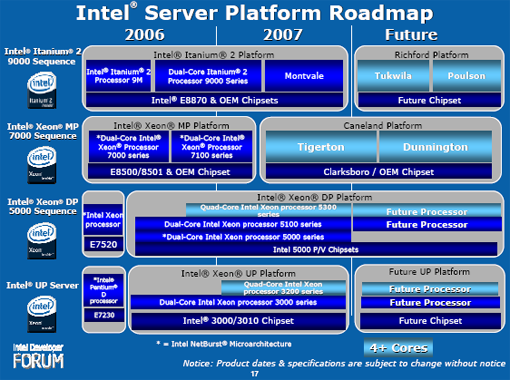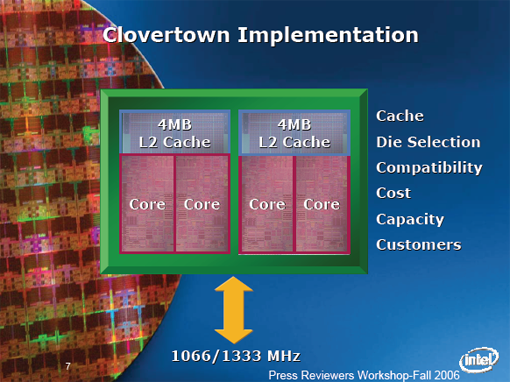Intel Clovertown: Quad Core for the Masses
by Jason Clark & Ross Whitehead on March 30, 2007 12:15 AM EST- Posted in
- IT Computing
Architecture & Roadmap
It's no secret that Clovertown isn't what the purists would call a "true quad core" architecture; it is two Woodcrest processors joined together in a single package. Does it matter? In our opinion, no. Clovertown performs very well, as you will see later in the article.
Clovertown is going to be with us for most of 2007 until Penryn is released, which is essentially a die shrink to 45nm. It is doubtful we will see a "true" quad core Intel part until the next generation architecture is released in 2008, code-named Nehalem. Below is the most recent server roadmap we have for the server platform. The part marked "Future Processor" in the Xeon DP Platform and UP Platform is Nehalem. You can read more about Nehalem and Penryn in our recent article on that subject.

Clovertown at its heart is two Woodcrest parts connected together on a single package. Each pair of cores shares a single 4MB of L2 Cache, just like Woodcrest and the pair of cores shares a single 1066/1333 MHz pipe. For most Woodcrest systems, Clovertown will be a drop-in replacement after a BIOS upgrade. We tested the Clovertown in a spare Supermicro board we had in the lab, and had no issues upgrading it from dual core to quad core. For a more in-depth analysis of Clovertown architecture, check out a Johan's very thorough write-up on Clovertown.

It's no secret that Clovertown isn't what the purists would call a "true quad core" architecture; it is two Woodcrest processors joined together in a single package. Does it matter? In our opinion, no. Clovertown performs very well, as you will see later in the article.
Clovertown is going to be with us for most of 2007 until Penryn is released, which is essentially a die shrink to 45nm. It is doubtful we will see a "true" quad core Intel part until the next generation architecture is released in 2008, code-named Nehalem. Below is the most recent server roadmap we have for the server platform. The part marked "Future Processor" in the Xeon DP Platform and UP Platform is Nehalem. You can read more about Nehalem and Penryn in our recent article on that subject.

Clovertown at its heart is two Woodcrest parts connected together on a single package. Each pair of cores shares a single 4MB of L2 Cache, just like Woodcrest and the pair of cores shares a single 1066/1333 MHz pipe. For most Woodcrest systems, Clovertown will be a drop-in replacement after a BIOS upgrade. We tested the Clovertown in a spare Supermicro board we had in the lab, and had no issues upgrading it from dual core to quad core. For a more in-depth analysis of Clovertown architecture, check out a Johan's very thorough write-up on Clovertown.











56 Comments
View All Comments
TA152H - Saturday, March 31, 2007 - link
Jarrod,Your power remarks are off because you ignore the problems heat creates besides the electricity. Working for one company for three years isn't a huge sample set, you know. I have worked for a lot of big companies, and they all are a little different. With regards to heat, you have to evacuate that heat too. Air conditioning and raised floors can get expensive. Reliability is also impacted by heat. It's not a simple dollar amount based on what the processors use. Also, your argument is deceptive at best and meant to confuse. Did you choose these processor based on power/performance ratio? You picked the best from AMD and Intel in this regard and did the comparison? No, you didn't. You chose what you had.
A lot of times dumb people from IT buy really expensive stuff on purpose, so they show they needed the entire IT budget that year and waste it so it isn't made less the subsequent year. I have been part of that, so what you're saying doesn't surprise me. In fact, I have been part of situations where we bought stuff just to buy it, so we'd use up the entire allocation. I have also been in situations where every last dollar is scrutinized. My remarks about IBM were to illustrate that cost matters. Not to everyone, and sometimes in a reverse logic way like I mentioned above, but for most people it does. If it didn't, why would AMD even bother selling mid range eight way Opterons since everyone would want the best ones? Hmmmmm, it's not the power usuage is much lower, so what is it? I guess it's cost. Why are there more than one Itanium part from Intel when they are used almost exclusively in very expensive machines? Hmmmm, cost again? I think Intel and AMD have a pretty good grip on that, and they do sell multiple tier parts for even expensive segments. So, it does matter, although admittedly in individual cases in perverse ways.
I don't like your graphs because they don't convey any story correctly. I don't like that you compared wrong parts. I wouldn't expect graphs to tell the whole story, they can't, but I expect the part they do tell to make some sense. But, again, now I understand it was availability and I don't have a problem with it. Before, I was aghast at your seemingly horrible choice for the comparison. I'm not anymore.
The article probably does convey some useful information, my point was it could have conveyed a lot more with better choices. I don't have a problem with AMD being better at certain things, I knew that and accept that. I like it, in fact. I don't expect much from the P9 either, since Intel (strangely like Motorola with their 68K line) seems to have lousy odd number parts, and from what I'm reading it doesn't seem very good. I hope I'm wrong, but I have a bad feeling about it.
I never said you had any ties to either company, or even implied that you were intentionally favoring one over the other. Don't read anything into what I say, I say what I mean and if I thought you were intentionally screwing Intel, I'd have said so. I just didn't buy the nonsense about how good the choices were when I knew they sucked, and you did too. You should have just been upfront about why, and I think everyone would have understood. It's certainly better than nothing, and those were you two choices. I can't argue with that. Well, I could, but it would be specious at best :P.
yyrkoon - Saturday, March 31, 2007 - link
I'd like to point out that I read the whole article, and knew the differences. The simple matter of the fact is that what anandtech was supplied with is what was tested. End of line. Period. Did Intel not send its higher performing parts, because they do not perform as well as the Opterons also (unlikely, but possible) ? Who knows. Unless you have the parts yourself to test, you will never know.What next ? "you didnt explore the fine raindeer effect" ? Please . . .
Frumious1 - Friday, March 30, 2007 - link
About the only people that would really get upset by this type of article are fanboys or employees of Intel and/or AMD. In this case it would probably only be Intel simply because this is a test scenario where Intel isn't substantially ahead. In fact, AMD is probably quite pleased to see some more "fair" results posted. I wouldn't argue much more, Jarred, without this guy specifically answering the following question.Are you employed by Intel, Mr. TA152H, and is that why you're upset? Wasn't there a law passed recently about disclosure for such things being required? I remember http://www.anandtech.com/cpuchipsets/showdoc.aspx?...">another article where your posts smacked of guerilla marketing, and this is the case again. You're upset that AT didn't tell the story Intel would like to see. At least that's how I see it.
TA152H - Saturday, March 31, 2007 - link
Well, actually, you're a dolt.I actually have preferred AMD to Intel most of the time, and was instrumental in bringing them into our company when the Athlon came out, because we were doing computational fluid dynamics and the x87 on it was better.
I have had a lot of dealings with both companies, and actually like them both. I don't want Intel to dominate the way they did, but I don't like articles that are misleading either. I don't have any problem with people saying AMD is better, when they are, but this type of article is bad. I can understand the problems acquiring parts, and they might have said that in the first place and I would have agreed. I don't like the false arguments, which are wrong and misleading, that rationalize the real reason. They should have just told the truth, this is what we got, this is what we tested, instead of trying to hide it and say they chose these because they were the best choices for the comparison. They weren't, that was my point, and I won't back off of it.
Viditor - Friday, March 30, 2007 - link
True, but from what we've seen when dual core Opterons came out, putting the cores on-die is a greater advantage than the bandwidth addition from the sockets.
By this I mean that the 1P/DC Opterons consistently beat out the 2P/SC Opterons on most everything (except bandwidth of course)...though the difference was only 5% or so as I recall.
Also, http://www.anandtech.com/showdoc.aspx?i=2897&p...">Johan's Article seems to suggest just these results...he states:
"Here is a first indication that quad core Xeon does not scale as well as the other systems. Two 2.4GHz Opteron 880 processors are as fast as one Xeon 5345, but four Opterons outperform the dual quad core Xeon by 16%. In other words, the quad Opteron system scales 31% better than the Xeon system"
ButterFlyEffect78 - Friday, March 30, 2007 - link
Thanks for clearing that up for me because I thought it was a simple 2 socket quad core setup. So does this mean you will be able to have 4xk10 quad possible in the future? That is 16-way Opteron box and will Intel have anything to compete with that?